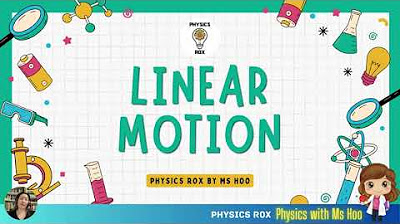Gerak Pada Benda: Jarak, Perpindahan, Kelajuan, dan Kecepatan
Summary
TLDRThis video explores the concepts of distance, displacement, speed, and velocity. It explains how distance is the total length of the path traveled, while displacement refers to the straight-line distance between an object's starting and final positions. The video breaks down the differences between speed (which ignores direction) and velocity (which considers direction). Through practical examples, such as a child moving to the right and returning, and a car moving in different directions, the video demonstrates how to calculate each of these values using simple formulas. It also encourages viewers to apply the knowledge through exercises and real-world scenarios.
Takeaways
- 😀 Distance is the total length of the path traveled by an object, regardless of direction.
- 😀 Displacement is the straight-line distance between the initial and final positions of an object, considering direction.
- 😀 The distance traveled by the child in the video is 10 meters, while the displacement is zero because they end up at the same position.
- 😀 Speed is the distance traveled divided by the time taken and does not consider direction.
- 😀 Velocity is the displacement of an object divided by the time taken and does take direction into account.
- 😀 Both speed and velocity have the same formula (V = distance or displacement / time) but differ in their consideration of direction.
- 😀 A car example is used to explain distance, displacement, speed, and velocity, where the total distance is 20 meters, and the displacement is 4 meters.
- 😀 The formula for calculating speed is distance traveled divided by travel time, while velocity is displacement divided by travel time.
- 😀 In the racing car example, distance is calculated by adding the lengths of the paths in the east and north directions.
- 😀 The displacement in the racing car example is found by using the Pythagorean theorem to calculate the hypotenuse of the right triangle formed by the two path segments.
- 😀 The video emphasizes the importance of understanding the difference between speed and velocity and offers practical examples for better comprehension.
Q & A
What is the difference between distance and displacement?
-Distance is the total length of the path traveled by an object, regardless of direction. Displacement is the straight-line distance between the initial and final positions of the object, considering direction.
What does the concept of speed focus on?
-Speed is the measure of how quickly an object moves, calculated by dividing the total distance traveled by the time taken, without considering the direction of motion.
How is velocity different from speed?
-Velocity is similar to speed but it takes direction into account. It is the rate of change of displacement, and is calculated by dividing displacement by the travel time.
What formula is used to calculate both speed and velocity?
-The formula used is V = d / t, where V is speed or velocity, d is the distance or displacement, and t is the time.
How do you calculate the displacement in a scenario where an object moves in multiple directions?
-Displacement is calculated by determining the straight-line distance from the initial to the final position, often using the Pythagorean theorem if the motion forms a right triangle.
If a child moves 5 meters to the right and then returns to their original position, what is their displacement?
-The displacement is zero because the child returns to the same position, despite covering a distance of 10 meters.
What is the relationship between the distance and displacement when an object returns to its starting point?
-The distance will be the total length of the path traveled, while the displacement will be zero, as the object ends up at the same position it started.
How is speed calculated in the example where a car travels a total distance of 20 meters in 10 seconds?
-Speed is calculated as distance divided by time, so for the car, speed = 20 meters / 10 seconds = 2 meters per second.
How is the velocity of an object calculated, and how does it differ from speed?
-Velocity is calculated by dividing the displacement by time. It differs from speed as it considers the direction of the object's movement.
In the example with the racing car that moves 80 meters east and 60 meters north, how is displacement calculated?
-Displacement is calculated by finding the hypotenuse of the right triangle formed by the eastward and northward paths using the Pythagorean theorem: displacement = √(80² + 60²).
Outlines

Cette section est réservée aux utilisateurs payants. Améliorez votre compte pour accéder à cette section.
Améliorer maintenantMindmap

Cette section est réservée aux utilisateurs payants. Améliorez votre compte pour accéder à cette section.
Améliorer maintenantKeywords

Cette section est réservée aux utilisateurs payants. Améliorez votre compte pour accéder à cette section.
Améliorer maintenantHighlights

Cette section est réservée aux utilisateurs payants. Améliorez votre compte pour accéder à cette section.
Améliorer maintenantTranscripts

Cette section est réservée aux utilisateurs payants. Améliorez votre compte pour accéder à cette section.
Améliorer maintenantVoir Plus de Vidéos Connexes

Kinematics in 1 dimension part 1

Distance displacement speed velocity acceleration for IGCSE Physics, GCE O level Physics

Gerak Benda dan Makhluk Hidup di Lingkungan Sekitar

Linear Motion - Distance, Displacement, Speed, Velocity, Acceleration - SPM & IGSCE Physics

Cinemática 05: Velocidade Média, Velocidade Escalar Média, Velocidade Instantânea

BAB 4 : GERAK DAN GAYA | Part 1 : GERAK BENDA | IPA SMP Kelas 7 Kurikulum Merdeka
5.0 / 5 (0 votes)
